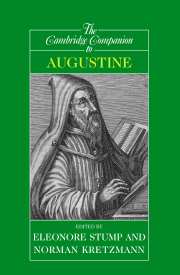Book contents
- Frontmatter
- Introduction
- 1 Augustine
- 2 Faith and reason
- 3 Augustine on evil and original sin
- 4 Predestination, Pelagianism, and foreknowledge
- 5 Biblical interpretation
- 6 The divine nature
- 7 De Trinitate
- 8 Time and creation in Augustine
- 9 Augustine’s theory of soul
- 10 Augustine on free will
- 11 Augustine’s philosophy of memory
- 12 The response to skepticism and the mechanisms of cognition
- 13 Knowledge and illumination
- 14 Augustine’s philosophy of language
- 15 Augustine’s ethics
- 16 Augustine’s political philosophy
- 17 Augustine and medieval philosophy
- 18 Post-medieval Augustinianism
- Bibliography
- Index
12 - The response to skepticism and the mechanisms of cognition
Published online by Cambridge University Press: 28 May 2006
- Frontmatter
- Introduction
- 1 Augustine
- 2 Faith and reason
- 3 Augustine on evil and original sin
- 4 Predestination, Pelagianism, and foreknowledge
- 5 Biblical interpretation
- 6 The divine nature
- 7 De Trinitate
- 8 Time and creation in Augustine
- 9 Augustine’s theory of soul
- 10 Augustine on free will
- 11 Augustine’s philosophy of memory
- 12 The response to skepticism and the mechanisms of cognition
- 13 Knowledge and illumination
- 14 Augustine’s philosophy of language
- 15 Augustine’s ethics
- 16 Augustine’s political philosophy
- 17 Augustine and medieval philosophy
- 18 Post-medieval Augustinianism
- Bibliography
- Index
Summary
Augustine, like Newman, was not by temperament inclined to acquiesce in prolonged or systematic doubt. Yet his growing dissatisfaction with Manichaeism, whose dogmatic dualism he had embraced as an eighteen-year-old in 372, made him a temporary skeptic in about 383 or 384, at a particularly insecure and unstable period of his life. A year or two later he encountered Platonism in Milan, and gradually laid the foundations of the theory of cognitive certainty that characterizes his earliest extant writings. He was subsequently to argue polemically that skepticism is a form of despair of finding truth. Yet he considered the refutation of skepticism to be of primary importance. He devoted the first of the programmatic series of philosophical writings of 386-387, Contra Academicos, written in the aftermath of his conversion, to criticism of skeptical positions and defense of the attainability of knowledge. He continued, moreover, to use skeptical arguments and method in his writings: they are found, for example, in his anti-Manichaean polemic from 388 onwards, and some survived in his later, mature thought.
- Type
- Chapter
- Information
- The Cambridge Companion to Augustine , pp. 159 - 170Publisher: Cambridge University PressPrint publication year: 2001
- 4
- Cited by



